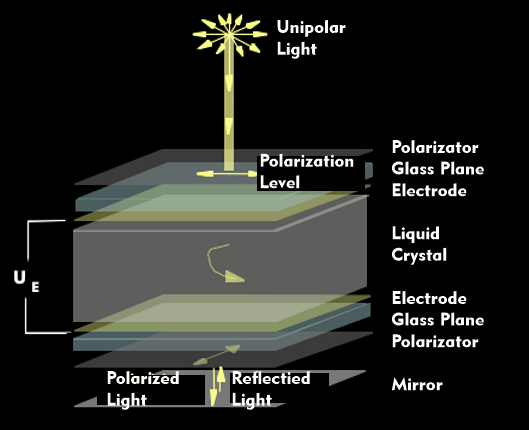liquid crystal display (LCD)
Liquid Crystal Displays(LCD) are liquid crystal displays. They are used in display modules, monitors, cell phones, computer games and, above all, in mobile communication and consumer electronics devices. LCD displays are based on liquid crystal cells in TN (twisted nematic) technology.
This technology exploits the effect that polarized light passing through liquid crystal molecules is rotated in its plane of polarization. When an electric field is applied to the liquid crystal cell, the liquid crystal molecules orient themselves parallel to the electric field, cancelling the rotation of the plane of polarization. The parallel orientation of the molecules is called nematic.
In LCD displays, a distinction is made between passive and active processes. The passive method uses a mirror located behind the TN cell for light reflection. If no voltage is applied, polarized light falls through the TN cell onto the mirror, is reflected there and exits the TN cell again. This gives the display a silvery appearance. If a voltage is applied, the light in the TN cell is not polarized and thus cannot pass the second polarization plane and does not fall on the mirror. No incident light is reflected.
Other methods use a backlight instead of the mirror so that the LCD display can be seen in the dark.
Active LCD displays
Active liquid crystal displays work with thin film transistors, hence the name TFT-LCD display, for Thin Film Transistor. Here, the alignment of the liquid crystals is influenced by an applied electrical voltage. The crystals change their properties and reflect the background light or allow it to pass through, which is referred to as reflective or transflexive operation. In this process, the thin-film diodes take over the control of the liquid crystals. This process is characterized by high contrast values and has the advantage that it can be used in daylight.
The most important characteristic values
LCD displays have contrast ratios of around 1,000:1. To improve this ratio, High Dynamic Range( HDR) is a process in which the backlighting is unevenly distributed depending on the image content. The background is illuminated brighter in areas with lighter picture content, and darker in darker areas. HDR displays thus achieve a dynamic range of up to 200,000:1.
LCD displays are connected to personal computers(PCs) digitally via Digital Flat Panel ( DFP), the Digital Visual Interface( DVI), DisplayPort, Plug and Display(PnD) or the Unified Display Interface( UDI). LCD displays are used as display modules in electronic devices such as clocks, calculators, measuring instruments, vehicles, vending machines, etc.


